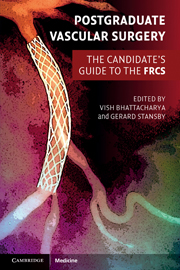Book contents
- Frontmatter
- Contents
- List of contributors
- Preface
- Section 1 Final FRCS vascular clinicals
- Section 2 Final FRCS vascular topics
- 1 Vascular risk factors and their management
- 2 Management of acute limb ischaemia
- 3 Chronic lower limb ischaemia, critical ischaemia and the diabetic foot
- 4 Endovascular and surgical options for peripheral revascularisation
- 5 Abdominal aortic aneurysms
- 6 Thoracic, thoracoabdominal and suprarenal aortic aneurysms
- 7 Aortic dissection
- 8 Popliteal artery aneurysms
- 9 Femoral artery aneurysms
- 10 Carotid, subclavian and vertebral disease
- 11 Diagnosis and management of thoracic outlet syndrome
- 12 Diagnosis and management of hyperhidrosis
- 13 Chronic mesenteric ischaemia
- 14 Acute ischaemic colitis
- 15 Vascular trauma
- 16 Indications and management of lower limb amputation
- 17 Leg swelling and lymphoedema
- 18 Varicose veins and chronic venous insufficiency
- 19 Management of deep vein thrombosis
- 20 Infection in vascular surgery
- 21 Vascular malformations
- 22 Vasospastic disorders and vasculitis
- 23 Critical care considerations and preoperative assessment for general and vascular surgery
- 24 Access surgery
- 25 Basic outline of solid organ transplantation
- Index
- References
1 - Vascular risk factors and their management
- Frontmatter
- Contents
- List of contributors
- Preface
- Section 1 Final FRCS vascular clinicals
- Section 2 Final FRCS vascular topics
- 1 Vascular risk factors and their management
- 2 Management of acute limb ischaemia
- 3 Chronic lower limb ischaemia, critical ischaemia and the diabetic foot
- 4 Endovascular and surgical options for peripheral revascularisation
- 5 Abdominal aortic aneurysms
- 6 Thoracic, thoracoabdominal and suprarenal aortic aneurysms
- 7 Aortic dissection
- 8 Popliteal artery aneurysms
- 9 Femoral artery aneurysms
- 10 Carotid, subclavian and vertebral disease
- 11 Diagnosis and management of thoracic outlet syndrome
- 12 Diagnosis and management of hyperhidrosis
- 13 Chronic mesenteric ischaemia
- 14 Acute ischaemic colitis
- 15 Vascular trauma
- 16 Indications and management of lower limb amputation
- 17 Leg swelling and lymphoedema
- 18 Varicose veins and chronic venous insufficiency
- 19 Management of deep vein thrombosis
- 20 Infection in vascular surgery
- 21 Vascular malformations
- 22 Vasospastic disorders and vasculitis
- 23 Critical care considerations and preoperative assessment for general and vascular surgery
- 24 Access surgery
- 25 Basic outline of solid organ transplantation
- Index
- References
Summary
Key points
Peripheral arterial disease (PAD) is an under-diagnosed and under-treated condition
Patients with PAD have a cardiovascular risk profile equivalent to or worse than those with coronary or cerebrovascular disease
PAD patients with concomitant symptomatic cardiac or cerebrovascular disease, diabetes or a low ankle pressure index are at even higher risk of sustaining a vascular event
Patients with PAD should receive the same risk factor management as patients with other cardiovascular diseases
Patient awareness of the need for cardiovascular secondary prevention therapy in PAD is low
The need for cardiovascular risk factor management in patients with peripheral arterial disease
PAD is a condition that is frequently under diagnosed and often the subject of suboptimal care. The first line treatment for patients with PAD is cardiovascular risk factor management with the aim of improving patient survival. This is because patients with PAD have a two- to threefold increased risk of cardiovascular mortality compared to an age- and sex-matched control population. The risk of a patient with PAD dying from a heart attack is believed to be equivalent to those patients who have already survived their first myocardial infarction.
The global Reduction of Atherothrombosis for Continued Health (REACH) registry has recently been established to determine atherothrombotic risk in more than 68,000 at-risk patients. To date it has shown that, compared to patients with coronary heart disease or cerebrovascular disease, those with PAD had the highest rates of cardiovascular death, myocardial infarction, stroke, or hospitalisation for atherothrombotic events at 1-year follow up (Figure 1.1).
- Type
- Chapter
- Information
- Postgraduate Vascular SurgeryThe Candidate's Guide to the FRCS, pp. 37 - 48Publisher: Cambridge University PressPrint publication year: 2011



